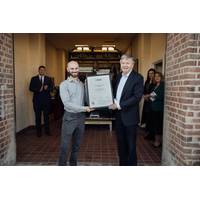
Fugro's ROV Training Course Gets IMCA Approval
Fugro's remotely operated vehicle (ROV) introductory training course has received International Marine Contractors Association (IMCA) approval in what has been described as a 'world-first endorsement.'According to Fugro, the IMCA approval ensures that only appropriately trained and competent individuals enter the ROV industry, helping to maintain high safety standards and quality services to clients."Participants will have the opportunity to attend the course in person at Fugro's recently opened ROV Training Centre of Excellence – a part of the Fugro Academy Training Centre
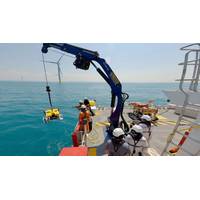
Taiwan's DWTEK Showcases Its Underwater Technology at Ocean Business
," DWTEK said.Thanks to the offshore wind power development, the demands on underwater construction [in Taiwan] increased, and DWTEK has taken part in the country's offshore wind development by providing self-designed and built ROV, underwater connectors, thrusters, and components, alongside IMCA ROV Pilots, assisting in OWF inspection and the maintenance, and foundation, marine growth, and scour inspections. In recent years, DWTEK also assisted National Geographic in 2019 with ocean wreck research, also collaborated with a Denmark energy company to implement a wind farm project
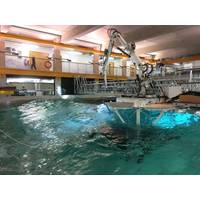
Tech File: A Robotic Reach in Offshore Wind
to 20m above the sea surface and another, an articulated system, for launch and recovery of remotely operated vehicles (ROVs) and AUVs, using a remote sensing system.Andreas Fechs, project and business development manager at STL, explained both systems at the joint Society of Underwater Technology (SUT), IMCA and Hydrographic Society Scotland seminar in Aberdeen in mid-November.A key goal has been to improve the safety of and ability to access offshore structures, initially fixed structures, from ships, including those that are relatively smaller than current gangway-system based vessels, he says. But
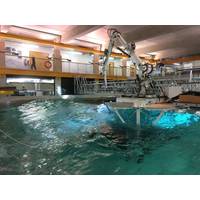
A Robotic Reach in Offshore Wind
up to 20m above the sea surface and another, an articulated system, for launch and recovery of remotely operated vehicles (ROVs) and AUVs, using a remote sensing system.Fechs Fechs, project and business development manager at STL, explained both systems at the joint Society of Underwater Technology (SUT), IMCA, and Hydrographic Society Scotland seminar in Aberdeen in mid-November.A key goal has been to improve the safety of and ability to access offshore structures, initially fixed structures, from ships, including those relatively smaller than current gangway-system-based vessels, he says. But another
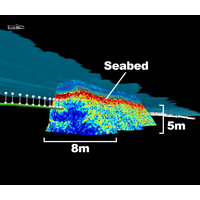
Kraken's PanGeo Subsea Completes Over $5 Million of Sub-Bottom Imager Projects
towed platform along several HVDC interconnector transmission cables. The SBI has also demonstrated success imaging buried fiber optic cables as small as 30mm, further expanding the market opportunities for this cutting-edge technology," Kraken Robotics said.In June, the SBI was added to the IMCA ‘Guidelines for the Measurements of Depth of Burial’ report, a comprehensive industry guide on how to conduct DOB surveys and what survey sensors to consider for verification.“The Sub-Bottom Imager has a strong history of delivering high-speed, high-resolution results in buried object
POSH, Seamec Kick Off Work on ONGC Pipeline Project
scheduling, and installation engineering aspects as lead partner of the consortium.POSH also said it has recently repurposed POSH Mallard as a DP2 DSV with ABS Class Notation including integrated Air and Saturation Dive systems, compliant with International Marine and Contractors Association (“IMCA”) and International Oil and Gas Producers (“IOGP”) standards. "Having been retrofitted with 300-meter Saturation and Air Dive systems and equipped with a 100T Subsea crane that can work in depths of up to 200 meters, POSH Mallard is now ready to support all forms of subsea

Subsea Expo Day 2: Remote and Autonomous Ops are the Trend, Barriers Remain
are behind the technology.David Rennie, Technical Manager, Autonomous Division, Unique Group, agrees. He told the same session: “The regulatory framework for using USVs is very unclear, which is holding things back. The technology has moved ahead and it’s making things tricky. The UK and IMCA are treating all USVs as boats rather than remote sensors.” Life buoys and rafts on Unmanned Surface Vessels?Rennie noted an ongoing discussion about a need for life buoys and rafts on USVs. “At some point that’s getting ridiculous, for a 3m boat, or is it?”

ROVs: Time for Renewal in the Work Class world?
and repair operations still need hydraulic, “because there’s a sea full of subsea production system equipment that requires hydraulic intervention,” he says.So, the future is more automated and maybe electric, with a greater mix of vehicles out there. Andy Rose, technical advisor at IMCA and a former ROV pilot, says, “I think we’re going to end up with a split, with big WCROVs doing construction and installation jobs and what’s traditionally been the inspection market will go over to AUVs, certainly for all survey.” We’ll be moving away from tethers,
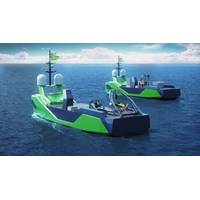
Autonomy: Inside the Building of Ocean Infinity’s Armada Fleet
remote control, each vessel will have two large satellite domes, in addition to VSAT and 3-5G communications capability. “You can miniaturize everything you want in robotics these days; you can make tiny computers and tiny computers,” says King, speaking at the joint Hydrographic Society, IMCA, SUT seminar. “But the one thing you can’t miniaturize is a satellite dish and the truth is a larger satellite dish gives you more bandwidth. Because we have larger vessels than traditional USVs we can mount 2-3 large domes on each and that enables us to have larger bandwidth, in turn



 February 2024
February 2024





